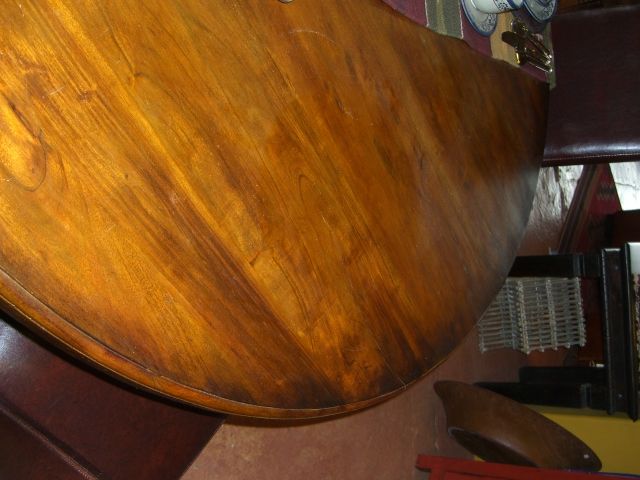Question
I have a client that needs a more durable finish applied to roughly 50 tabletops. The existing tables are new/unused and are made of rosewood with a nitrocellulose lacquer. The tables will be used in a restaurant and exposed to water/cleaning/usage typical of this setting. I want to apply the simplest finish method/material while still creating a good bond and durability. Any recommendations would be greatly appreciated.
Forum Responses
(Finishing Forum)
From contributor G:
The good news is that NC is easily stripped...

1) There isn't a durable product on the planet that I would trust to apply over NC lacquer. If anything, just clean them up, scuff and recoat with NC or CAB lacquer. Not any more durable than it was to begin with, but nicer looking (for a week or two, anyway).
2) If anyone has ever ever used something like Pledge or other silicone-containing furniture polish (likely, in a restaurant), you will get fish-eye. I charge the heck out of refinish jobs for this very reason. You will need some fish-eye killer (Sherwin Williams Silaway is like $50 a quart, but a quart will do more tables than you have time to refinish in this lifetime).
3) The only durable coating I'd trust (providing that you have stripped the easily-removed NC lacquer and resanded) is Waterlox. This is usually only available on the Net or paint stores that can special order it. Waterlox is a tung-oil based polyurethane (not waterbased, as sometimes assumed) and, as far as I can tell, is the best stuff around (because of the tung oil base). Get regular Waterlox, not the marine grade, as I personally think they are the same thing. Can't tell a difference other than the higher price. The problem with Waterlox is curing time. Hours per coat (I'd recommend minimum two, preferably 3).
If you upgrade your finishing (and have good HVLP spray equipment and a good spray hand), use 2K polyurethane (ML Campbell and ICA both sell a fantastic 2-part urethane).
The two-part urethane dries to a sandable finish in less than an hour (and three coats will be plenty).
2K urethane is harder, much more chemically resistant than any oil based polyurethane, and much more finisher-friendly. The only downside is cost per gallon, requirement of a spray hood/spray guns, and the fact that you have 15 minutes to spray the quart you just catalyzed or it will gel up in your gun (this is easy to deal with though).
The last thing - charge the dickens out of them just in case you get fish-eye (likely). The Silaway will work in any oil based urethane, lacquer, or 2K urethane. If you wind up overcharging and you get no fisheye, you can refund them if you need to.
That little bit of burnt edging could be reapplied with a spray gun in about two or three minutes per table. I'd resand the tops and refinish with tinted polyurethane. By the way, I am reasonably sure that those tops are not rosewood... Rosewood has quite a different look and would drive the cost of such tables up by at least several hundred dollars each. If sufficient supply could be found at all. I see rosewood lumber currently offered at from $18.75 to $89.00 per board foot (4/4). They could be cherry, maple, birch, alder, etc. - most likely birch.
Trouble is, the questioner really wants something that he (his client) can't have at this point: "the simplest finish method/material while still creating a good bond and durability." No can have.
My guess is that the tables should have been manufactured overseas and sent over in the raw stage and then finished here in the United States with a more appropriate coating. I know you're interested in presenting a complete and proper job to the client, so have someone strip the entire table including the bases down to raw wood and start over from scratch. Determine what you mean by durability and apply a finish that meets your expectations.
You must take the previous finish off and recoat with a urethane or polyurethane type coating to be sufficient enough for durability. Do not listen to what anyone else says about recoating with whatever else.
1. The existing finish must be clean. An alkaline cleaner like TSP will clean both water soluble and solvent soluble contaminants.
2. The surface must be etched or roughed up to promote a good mechanical bond with the new finish. This can be accomplished with scuff sanding, or the TSP does a nice job of etching many finishes; most notably, shellac and lacquer.
3. You want to avoid coating over a finish that is sensitive to lacquer thinner with a coating that contains lacquer thinner. You can get by with it, but your first several coats need to be very thin. Not a problem here because we're talking varnish over lacquer.
I also avoid putting a brittle finish over a soft one. Again, not a problem here. But if soft over hard is a problem, why do we use dewaxed shellac as a sealer/barrier coat under most anything? And what makes sanding sealer easy to sand?
Stripping would be a better place to start, but it is not the only place to start. Thanks for trying to set me straight but I think I'll stick with tried and true for now.
Also, what makes sanding sealer sand so well? It's the talc.
I would never, under any circumstance, spray something like CV or 2K urethane over shellac (I don't even own any shellac except for the shellac that is used to coat one of my prescription medication capsules). No need for it in industrial stuff.
Price it profitably, strip 'em, and recoat with some good stuff - lots of good things recommended here.